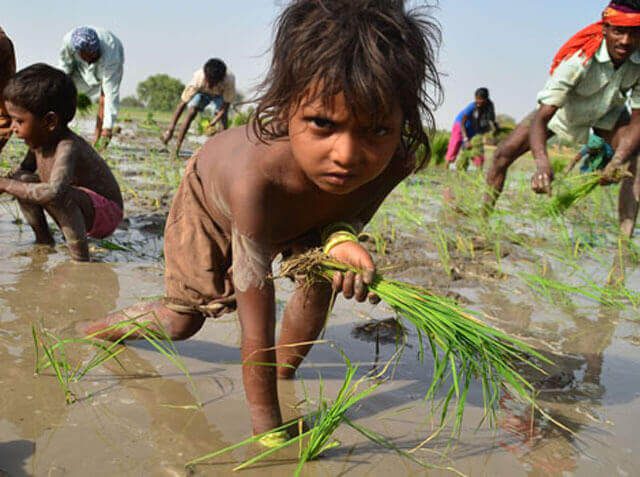As the World Day against Child Labour (12th June) this year comes with the slogan ‘Children shouldn’t work in fields, but on dreams’, CRY-Child Rights and You calls for taking a closer look at the reality and taking them back to schools. A report for Different Truths.
No matter how unbelievable it sounds, most of the working children in India don’t toil in factories and workshops or work as domestic helps or street vendors in urban areas. On the other hand; they are working in fields and farms, planting and harvesting crops, sprinkling pesticides or spraying manures, and are often tending livestock at farms and plantations, according to a media release.
Going by the Census 2011 dataset released in 2016, a whopping 62.5 per cent of working children and adolescents below 18 years are engaged in agriculture and related industries. In absolute numbers, among 40.34 million of working children and adolescents, 25.23 million work in agricultural sector.
Going by the Census 2011 dataset released in 2016, a whopping 62.5 per cent of working children and adolescents below 18 years are engaged in agriculture and related industries. In absolute numbers, among40.34 million of working children and adolescents, 25.23 million work in agricultural sector, it was informed.
According to recent global estimates by International Labour Organisation (ILO), there are approximately 152 million children in child labour and seven out of every 10 working children are in agriculture. The current trends in India reflect a very similar picture, with more than 60 per cent of children in India being part of the economy sustained by agriculture and related activities. ILO also considers agriculture to be the second most hazardous occupation globally, the release stated.
In some states in India, however, the figure is much higher than the national average. While in Himachal Pradesh the percentage of children working in agriculture soars as high as 86.33 per cent, in Chhattisgarh and Nagaland it stands at 85.09 per cent and 80.14 per cent respectively.
In some states in India, however, the figure is much higher than the national average. While in Himachal Pradesh the percentage of children working in agriculture soars as high as 86.33 per cent, in Chhattisgarh and Nagaland it stands at 85.09 per cent and 80.14 per cent respectively. Among the big states, Madhya Pradesh (78.36%), Rajasthan (74.69%), Bihar (72.35%), Odisha (69%) and Assam (64.42%) fare poorly in comparison to the national figures, it was emphasised.
Overall estimates suggest that in India there are 40.34 million working children and adolescents between 5-19 years (62 per cent of them are boys and 38 per cent are girls), stated the media release.
Put in simpler terms, three in every four working children are virtually denied of their right to education.
A closer look at the Census 2011 data analysis by CRY-Child Rights and You suggests that children engaged in agricultural work majorly miss out on the opportunity of an education. Among the total 40.34 million working children and adolescents within the age-group of 5-19 years, only 9.9 million attend educational institutions, which mean only 24.5% of the working children go to school. Put in simpler terms, three in every four working children are virtually denied of their right to education, it was stated.
As the data suggests, it is a huge challenge for children to balance work and education. Census 2011 data reveals that only a miniscule percentage of children who are involved in agriculture are able to continue education, despite the provisions of the Right to Education (RTE) Act being in place, reiterated the release.
Priti Mahara, Director Policy Advocacy and Research at CRY said, “The Child Labour Law allows children under the age of 14 years to ‘help’ in family enterprises beyond school hours…
Priti Mahara, Director Policy Advocacy and Research at CRY said, “The Child Labour Law allows children under the age of 14 years to ‘help’ in family enterprises beyond school hours. This is fraught with far-reaching effects on children’s right to learn, play and develop, as a whole, and more specifically on those who are ‘helping’ out their parents in agricultural work.”
From the perspective of children, agriculture has its own set of hazards, too. For example – handling pesticides, agricultural equipment and so on, can cause severe long-term damages to children’s still developing bodies.
Children, working in the fields, face serious dangers such as exposure to pesticides as well as pesticide-contaminated water and food. For children working in farms, hours of work can get extremely long during planting and harvesting.
“Experiences gathered from past four decades of work with children and their communities go on to suggest that majority of the agricultural work in our country is carried out in situations where there is hardly any boundary between working and living conditions. Children, working in the fields, face serious dangers such as exposure to pesticides as well as pesticide-contaminated water and food. For children working in farms, hours of work can get extremely long during planting and harvesting. It is physically demanding and strenuous, involving long periods of standing, stooping, bending and carrying heavy or awkward loads,” Mahara explained.
The first step to address the issue is to address the reasons that force children to work, says Priti Mahara. “Children work mainly to help their families because the adults do not have adequate income. Children work also because there is a demand for cheap labour in the market. When they are forced to work for long hours, their chance of attending school gets limited, preventing them from gaining an education. Their time to play and leisure is somehow compromised.”
“The underlying issues can be resolved by ensuring that children are sent to school, not to the fields. This can be achieved through adequate quality schooling especially focussing on the inclusion of children from marginalised sections along with effective monitoring and grievance redressal mechanisms, interacting with teachers, parents, community leaders and children’s collectives on the importance of child education and the demanding effects of child labour. There is also a need to empower communities with the knowledge to demand proper implementation of livelihood schemes, food security and access to all government entitlements. And this is what we are also trying to do in CRY intervention areas,” Mahara concludes, according to the media release.
Photos from the Internet





 By
By

 By
By
 By
By